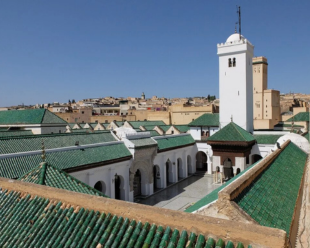
Fatima Al-Fihri: The Woman Who Championed Education and Founded the World’s First University
In ninth century Fez, Morocco, a woman named Fatima Al-Fihri established a center of learning to help youth and ended up founding the world’s first university, said to have paved the way for modern day higher-education institutions across the world. Founded in 859 CE, the Al-Qarawiyyin Mosque and University in Fez is the world’s oldest continually-operating university, and though forgotten by many, was established by a Muslim woman who championed education.
The university is also the first educational institution in the world to establish the practice of granting degrees. The university, started off as a mosque, slowly evolved into a center of religious learning and later grew to teach various faculties, including medicine and astronomy, attracting scholars from across the world. As early as the ninth century, the Al-Qarawiyyin University established a template of a multicultural seat of knowledge.
Fatima Al-Fihri, a Muslim woman from a well-educated family in Tunisia, migrated from Qayrawan in Tunisia to Fez in Morocco with her father and her sister. Al-Fihri came from a prosperous and devout Muslim family and her father, Muhammad al-Fihri, was a merchant who ensured that she and her sister, Mariam, were well-educated in Islamic jurisprudence and Hadith (the sayings of Prophet Muhammad). When her father died, she inherited a large fortune and she along with her sister used this to build a mosque and higher-education institution. She oversaw the construction of the building which included a courtyard, a prayer hall, library and classrooms. The construction of the al-Qarawiyyin Mosque started in 859 CE, during the month of Ramadan under her supervision.

Al Qawawiyyin Mosque as it stands today https://en.wikipedia.org/wiki/Fatima_al-Fihriya#/media/File:Qarawiyyin_Mosque_DSCF4250.jpg
A devout Muslim, many sources claim Fatima Al-Fihri fasted during the construction of the university, with some sources saying she fasted for up to 18 years. Al-Fihri often took students under her wing and earned the nickname “Mother of boys” because of her charitable ways to help the youth. She established the university with an intent to serve and educate the community.
Much of Fatima’s life remains shrouded in mystery. In 1323, a fire destroyed the Al-Qarawiyyin library and many of the books and volumes housed in the library were destroyed. These also included documents which had details of Fatima Al-Fihri’s early life.
Al-Qarawiyyin was originally established as a mosque and soon evolved into a madrassa or a center for religious education. Later, the curriculum expanded to include poetry, philosophy, logic, rhetoric, grammar, geography, science, mathematics and medicine. All of these courses were free of charge. The university’s reputation for academic excellence attracted scholars and students from across the world. The university is still in operation today and houses one of the world’s oldest libraries.
The university seeks to build bridges between different cultures and its vision is a world “where experts in Islamic sciences play a pivotal role in fostering global harmony”.
“Her idea for an educational hub that provided opportunities for advanced learning spread throughout the world in the Middle Ages, resulting in the founding of Europe’s oldest institutions in the following centuries, including the University of Bologna (founded 1088) and the University of Oxford (founded around 1096),” reported a 2017 article titled The true story of Fatima al-Fihri, the founder of the world’s first known university in the UK magazine Stylist.
During the medieval times, the Al-Qarawiyyin University was considered a major intellectual hub. At its peak, the university attracted hundreds of students from across the world. In the 13th and 14th century, the university’s library housed more than 30,000 books from across the world. Presently, the library hosts about 4,000 manuscripts and volumes. Symposiums and debates were commonplace at the university and it was a multicultural center.
After Al-Fihri’s death, the institution continued to be extended and the mosque became the largest in Africa, with a capacity of holding upto 22,000 people. Famous alumni of the university include Andalusi diplomat and geographer Hassan al Wazzan (Leo Africanus), Jewish philosopher Moses ben Maimon (Maimonides), Islamic philosopher Ibn Rushd (Averroes), historiographer and thinker Ibn Khaldun, and Sufi poet and philosopher Ibn Hazm.
Fatima Al-Fihri’s legacy in education has withstood the test of time and to this day, the university is dedicated to the revival of Islamic education through the Arabic language.
References:
The first picture is a portrait of Fatima Al Fihri. Source: https://www.dw.com/en/fatima-al-fihri-founder-of-the-worlds-oldest-university/a-53371150
https://www.culturefrontier.com/fatima-al-fihri/
https://www.dw.com/en/fatima-al-fihri-founder-of-the-worlds-oldest-university/a-53371150
https://alqarawiyyeenuniversity.org/overview
https://teachmideast.org/fatima-al-fihri/
(The views expressed in this article are the author’s own. Content can be used with due credit to the author and to ‘Zariya: Women’s Alliance for Dignity and Equality’)
About the Author:

Anam is a seasoned journalist with over a decade of experience covering education, health, and social issues in the UAE and across India and the UK. As the UAE Education Editor at The National newspaper, Anam leads in-depth reporting on education policies, trends, and community impact, engaging with global organizations like UNESCO, UNICEF, and WHO.
Anam was awarded the prestigious Rosalynn Carter Mental Health Journalism Fellowship, where she investigated the pandemic’s effects on teenage mental health in the UAE and GCC. Beyond journalism, Anam is passionate about sustainability, education advocacy, and public policy. She can be reached at anamrizvi1@gmail.com



